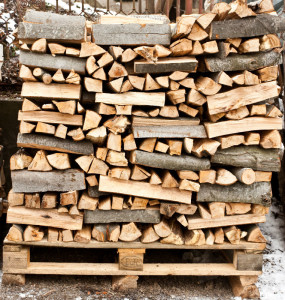While buying the right kind of seasoned firewood is important, how you store your wood can make have a major impact on how it burns. Without proper storage, even well-seasoned firewood can be can be ruined by moisture or rot.
The following are three of the most important tips for storing your seasoned firewood. By following these tips, you can make sure the money you spent buying firewood for the season isn’t wasted and you have enough fuel to last all winter long.
1. Store firewood on a rack
Firewood – whether it is already seasoned or freshly cut – should never be stored directly on the ground. Leaving wood directly on the ground can leave the bottom layer of wood susceptible to moisture, insects, rodents, and other vermin. A good fireplace storage rack should sit several inches off the ground, making sure no wood comes in contact with the ground below; this allows airflow while protecting the wood from rotting. If you don’t have the space or need for a large firewood rack, wood can also be stacked on treated boards.
2. Cover the top – but not the sides
While firewood is meant to be stored outside, too much water or moisture accumulation on the top of the pile can cause moisture damage. This water will eventually trickle down through the wood stack and cause rotting throughout the pile. To protect the wood, the top of the wood stack should be covered. If you do not have a shed or other covered outdoor area where wood can be stored, this can be as simple as covering the top of the wood stack with a tarp.
Just because the top of the stack is covered, however, doesn’t mean the sides should be. A good firewood stack requires airflow to continue the seasoning process as well as allow any moisture that has gotten into the wood pile to evaporate. Covering the entire wood stack reduces or eliminates airflow altogether; this can lead to even small amounts of moisture causing rotting in the wood.
3. Only bring in the wood you need
Indoor firewood storage may be increasingly popular in interior design, but it is not a practical way to store your seasoned firewood. First, firewood needs to be exposed to sun and wind in order to continue seasoning. Storing large amounts of wood indoors prevents any additional moisture from evaporating; this can cause wood with a high moisture content to be burned, leading to sluggish and low performing fires.
In addition to affecting the quality of your fires, storing firewood indoors can also invite in unwanted pests. Even properly stored firewood has been known to play host to a variety of insects; however, these bugs are largely dormant due to the cold temperatures outside. Storing large amounts of wood indoors – and at room temperature – can prevent the bugs from remaining dormant and unleash them on the rest of your home.

